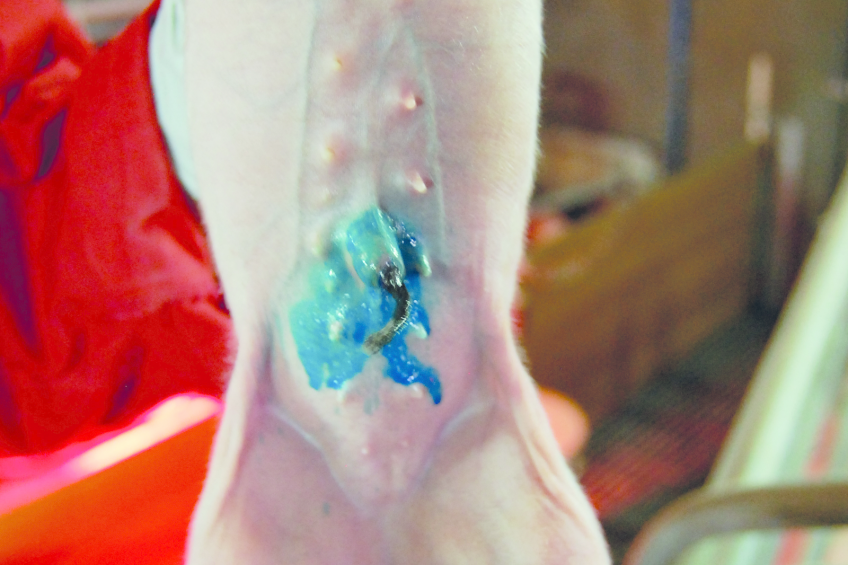The next step in skin disinfection

When talking about disinfection of the skin, it could be considered by some as a treatment that only occurs occasionally in livestock production. However, when we take a closer look we see that reality tells a different story.
Consulting visits with farm managers and veterinarians that work on a day-to-day basis in intensive livestock production, reveals the bare necessity of a good skin disinfectant that can be used routinely and implemented in standardised treatment protocols. Modern pig production is constantly challenged by for example legislation, public opinion, variable meat prices, disease outbreaks, export restrictions, animal welfare, etc. To overcome these challenges the industry is also driving forward on innovation and cost benefit solutions. Skin disinfection solutions make no exception to the rule.
For modern pig farming an antiseptic product should comply with three major parameters. First of all the product must work in real farm conditions where animals are confined, where there is a lot of manure, and where heat and humidity can occur. Secondly the product must be economic in use, hence it will be used routinely for piglet treatment. Last but not least skin disinfectants should be free of antibiotics. By eliminating routine, non-therapeutic uses of antibiotics, the meat industry can reduce the potential for antibiotic resistance and ensure these important drugs remain effective for treating when necessary. Cid Lines has developed a skin disinfectant spray named Kenofix which combines those three parameters. The product offers a protective barrier for the key areas of skin lesions in pigs: ears, skin, tail navel and hooves (Figure 1).
Figure 1 – Key areas of application of the disinfectant spray.

2-phase aerosol system
A spray can makes the product easy to apply, preserves the product longer and doesn’t require any handling or tools to apply it. The can itself is made of one piece of high quality aluminium which ensures that no welding must be done like is the case with thin cans. Also the can cannot rust.
The propellant is 100% homogenous with the product inside the can. This offers a real advantage in use in real farm conditions. It does not need shaking before use and can be used upside down. Furthermore the 2 phase-propellant system ensures no pressure difference inside the can when it is either empty or full. This brings yet another two major advantages for the user: The spray-can can be emptied completely and the output (consumption) when sprayed is always the same, from a full to empty can. This makes it economical in use.
The active ingredient in the product is clorocresol. It guarantees a very strong and fast bactericidal, virucidal and fungicidal activity. The product has demonstrated its efficacy according to the European norm EN1656 which validates a bactericidal activity towards Staphylococcus aureus, Enterococcus hirae, Streptococcus suis, Pseudomonas aeruginosa and Proteus vulgaris. (see Table 1). Furthermore it has also shown fungicidal activity according to the European norm EN1756.
Second skin technology
The biggest challenge for skin disinfectant products is to have the ability to disinfect and protect the wounded skin in real farm conditions. This means that the disinfected skin should maintain that status for as long as possible and be protected from the environment where the piglets are confined. This is where most of the ‘old-school’ skin disinfectants fail. They disinfect but don’t protect. Without this protection the efficacy of the skin disinfection will be very short because of the reintroduction of the treated animal in dirty conditions, where reinfection will occur.
To overcome this difficulty, a unique second-skin-technology has been incorporated into the product. The copolymers of the high quality plasticizer create a strong and flexible film on the skin. Hence the name ‘second skin technology’ as it operates like a bandage. This plastifier makes the film flexible and keeps it intact on the skin for a few days.
The film forming agent has a good skin adhesion and dries very fast. This is very important when treating piglets as it is necessary to have a product that dries fast so that it will not be rubbed off. The dry film will also have no outward stickiness. Once the film is dry it is not soluble in water which ensures that it will stay as long as possible on the skin. This second skin technology ensures an abrasion resistance film and a real physical protection from the environment.
Figure 2 – Remanence action (log4) of Kenofix against Streptococcus cuis for at least 4 days.
Prolonged release of biocidal substance
The biocidal substance is captured in the film. There it migrates towards the skin. This process will take place for at least 4 to 5 days. This remnant (residual) effect is demonstrated according to norm ISO22196. So the instant disinfection takes place directly after the product is applied and while it is still wet. Very soon the film dries and from that moment on the biocidal activity is further assured for at least four days (see Figure 2) when the disinfectant gets released slowly from the film. Furthermore the film is permeable for oxygen, allowing the skin to breathe which aids recovery.












